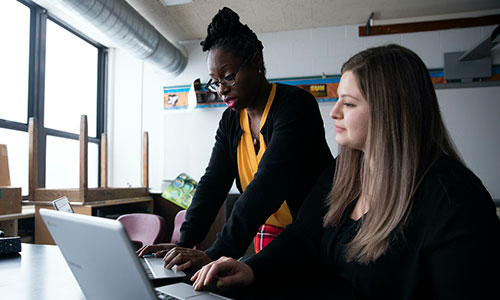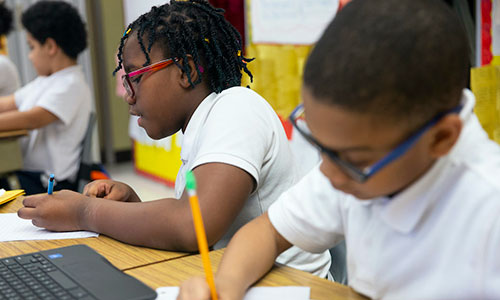
When I was a school administrator, I thought a lot about family engagement. How could I get more parents and guardians to feel connected to our school and interested in getting involved? How could I get my staff to connect to families?
Before you make any changes to how you approach and foster family engagement as principal, I encourage you to think about what your school is already doing. Knowing where you’re starting from will give you a better idea of where to go next.
Know what kind of school you lead
Think about your school and how it partners with families. How welcoming is it? Are there areas for improvement? Are there things that are working well? I find it can be helpful to read the following statements and decide which describe your school best:
- Family engagement is not the responsibility of teachers.
- We rely on a small group of parents to serve on committees.
- Families can visit only on designated days or times.
- Family activities are planned without family input.
- We have an open-door policy, and families are welcome to visit at any time.
- We hold different events for families throughout the school year.
- Families are involved in making school improvement decisions.
- Staff intentionally work to develop relationships with families.
If you chose A or B, you may be a Fortress School and family engagement is likely a low priority. If you chose C or D, you may be a Come-If-We-Call School: you set expectations for how your school and families can engage. If you chose E or F, you may be an Open-Door School that makes targeted efforts to engage families, and you also support families in advancing student learning. If you chose G or H, you may be a Partnership School and see family engagement as a top priority. You believe families are true partners in student learning and that they are valued contributors.
A framework that makes family engagement easier
Over the last two years, in my role supporting our professional learning teams, I have been part of an internal team dedicated to providing technical assistance to a district as part of a grant through the Bill and Melinda Gates Foundation. The grant is helping us support the district as they mitigate learning loss for students brought on by the challenges of learning during COVID-19 school closures. Our collaboration has focused on creating resources to support and increase family engagement and is based on the work of Karen Mapp and the Dual Capacity-Building Framework for Family–School Partnerships.
In Partners in Education: A Dual Capacity-Building Frameworks for Family–School Partnerships, Mapp and Paul Kuttner explain that there are six process conditions “that are important to the success of capacity-building interventions.” They go on to say that “Process conditions are key to the design of effective initiatives for building the capacity of families and school staff to partner in ways that support student achievement and school improvement.”
The six process conditions listed on the Dual Capacity website call for all family engagement initiatives to be:
- Relational: Built on mutual trust
- Linked to learning and development
- Asset-based
- Culturally responsive and respectful
- Collaborative
- Interactive
Let’s take a closer look at each one.
What it means to be relational
Supporting a relational approach built on mutual trust is the first process condition listed in the Dual-Capacity Framework, and this isn’t by accident. Mapp is well-known for saying that relational trust is the factor that enables all the other conditions to be possible.
How can you work toward being more relational and building trust? Too often, the first contact between families and a schoool are not positive. Many times, these initial interactions are about tasks that need to be completed to register a child for school, requests for school supplies, and the like. This can be off-putting for families, especially those with children just starting school.
I encourage you to aim for proactive communication that seeks to build trust and supports ongoing communication. One way to do this is to organize informal visits with families before the school year even begins or to commit to early positive phone calls focused on learning about them and their student.
Linking family engagement to learning and development
The second process condition in the framework calls on us to connect family engagement and learning and development. This supports student achievement, especially when we help families and students develop knowledge and skills.
One way to empower families is by sharing learning strategies. Support your teachers in creating online resources that help parents and guardians teach their kids strategies for solving math problems or improving reading at home. Let families know about our e-books made just for them: How to support writing at home: A guide for families and How to support reading at home: A guide for families.
Here’s another idea: share conversation prompts in your weekly email to families to support them in talking to their students about homework and home learning activities.
Family engagement that is asset-based
The third process condition is asset-based. This condition recognizes that families have strengths, skills, and resources that support students’ learning and school improvement. It encourages parents and guardians to both recognize and also leverage those.
Consider inviting family members to visit their child’s classroom and share a story about their lived experience. A family member can speak to a class about how they use math in their work at a hospital, for example. Or a family member from another country can describe their journey to the United States for a history class, or they can talk about their customs from their country of origin during a unit related to traditions.
Being culturally responsive and respectful
The Dual Capacity-Building Framework also calls on us to be culturally responsive and respectful. That is the fourth process condition, and it focuses on the family and cultural knowledge of all families in the learning process. It includes all of a family’s values, cultures, languages, and heritages. This process condition doesn’t ask us to invite families to share their backgrounds with us, as the previous condition does. Instead, it asks us to recognize that not all families are alike and to respond positively to these differences.
Families engage with schools in different ways, for example, and this can be partly due to their culture. Just because a family does not visit your building or participate in school-sponsored activities doesn’t mean they are not interested in their child’s education or that they dismiss the importance of education. For some, mispronouncing names can also lead to disengagement or discomfort because they see a teacher or school leader as an authority figure and are less willing to correct them.
Schools should identify and recognize different types of engagement to appeal to all families. Here are just a few ideas for how you could go about this:
- Provide families with a range of communication channels, from email and social media to phone calls and more
- Give families opportunities to talk to you and teachers in their preferred language
- Show interest in learning how to pronounce and spell names, and support your teachers in doing the same
Fostering collaboration
In many schools, collaboration between schools and families can be limited. The fifth process condition in the framework asks us to be collaborative. The collaborative process condition is strengthened when educators, families, and communities have positive community-building experiences together.
When planning for these events, bring educators, families, and community members together so everyone can take part in making them a reality. Consider reaching out to families in different ways when asking them to participate: your weekly email to families and a social media post and a text message and a flyer sent home with students.
Include kids in the preparation of school events, too. Consider having a competition to create that event flyer. Encourage current students to invite their families to attend, and reach out to former students as well. It may be fun for middle schoolers to attend the end-of-the-year carnival at their old elementary school, for example.
If any of your staff members have cultural ties to different communities, ask them to spread the word about an event.
Making initiatives interactive
The sixth process condition in the framework calls on us to find ways to make family engagement efforts interactive. Interactive family–school partnerships engage educators, families, and community members in opportunities to learn together. While traditional family engagement initiatives usually consist of schools disseminating information to families, interactive methods provide for two-way communication and collaboration.
Think about a traditional open house, where families come to your building, meet their child’s teacher, and are told about things like rules and curriculum. The communication is very one-way, and kids usually stay home with a sitter. Are there opportunities to invite children to join their adults? Just seeing their child excited to lead them to their desk or point out the gym and library can help parents and guardians feel more engaged. If kid-free is better, try this: Ask your teachers to invite parents and guardians to leave a note on their child’s desk or in their locker.
Consider getting creative about sharing curriculum information as well. What about hosting a family math night with games and activity stations later in the fall? Families and students can solve math problems together. The teacher can then explain how the math stations are aligned to the curriculum and standards.
A little goes a long way
Family engagement can feel like a lot to add to your already full plate. I encourage you to keep your goals realistic. Ask yourself, what is one thing I can do differently this week that can help my students’ families feel like a bigger part of our school community? Simply deciding that you’d like to try a family math night counts. Next week, you can take a second action that will help make it happen.
If you’d like to learn more, I encourage you to spend some time on dualcapacity.org and the family engagement pageon Edutopia. If you test with MAP® Growth™, the following can help you improve family engagement around assessment:






